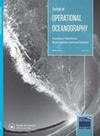Validation and application of model/reanalysis sea-level data to the establishment of the reference hydrographic surface in Spanish waters
IF 2.4
3区 地球科学
Q4 METEOROLOGY & ATMOSPHERIC SCIENCES
引用次数: 1
Abstract
ABSTRACT Sea-level reanalysis data fields from the Iberia-Biscay-Ireland Monitoring and Forecasting Center (IBIre) were analysed and validated with coastal tide-gauge and vertical positioning data from 110 experimental stations, complemented with the Technical University of Denmark global ocean tide model and mean dynamic topography DTU10, in order to establish the reference hydrographic surface (RHS) for Spanish waters. IBIre fitting to experimental tidal ranges, with mean errors about 10 cm, improves the DTU10 results along the Iberian Mediterranean shore due to an adequate reproduction of the ‘radiational’ tides. Regarding the mean dynamic topography, errors were also about 10 cm both for IBIre and DTU10 fields, and about 50% of them is plausibly related to the experimental uncertainness arising from the different averaging periods of observed series. Fitting of IBIre results to experimental data provides orthometric/ellipsoidal heights of the lowest astronomical tide with mean errors between 7 and 10 cm. IBIre sea-level data have enough quality to constitute a reliable basis for an operative RHS in Spanish waters, and plausibly in other regions within its spatial coverage. Moreover, IBIre sea-level data have other potential applications to the study of climate/sea-level trends, and improvements of the accuracy in de-tiding satellite-altimetry data in the western Mediterranean Sea.模型/再分析海平面数据在西班牙水域参考水文面建立中的验证与应用
摘要利用110个实验站的海岸测潮仪和垂直定位数据,结合丹麦技术大学全球海潮模型和平均动力地形DTU10,对来自伊比利亚-比斯开-爱尔兰监测预报中心(IBIre)的海平面再分析数据场进行了分析和验证,建立了西班牙海域的参考水文面(RHS)。ibiire拟合实验潮汐范围,平均误差约为10厘米,由于充分再现了“辐射”潮汐,改善了伊比利亚地中海沿岸的DTU10结果。对于平均动力地形,ibiire和DTU10场的误差也在10 cm左右,其中约50%的误差可能与观测序列平均周期不同引起的实验不确定性有关。将IBIre结果与实验数据进行拟合,得到天文低潮的正椭球面高度,平均误差在7 ~ 10 cm之间。ibiire的海平面数据具有足够的质量,可以构成在西班牙水域运行RHS的可靠基础,在其空间覆盖范围内的其他区域也有可能。此外,IBIre海平面数据在研究地中海西部气候/海平面趋势和提高除潮卫星测高数据精度方面还有其他潜在的应用。
本文章由计算机程序翻译,如有差异,请以英文原文为准。
求助全文
约1分钟内获得全文
求助全文
来源期刊
CiteScore
7.50
自引率
9.70%
发文量
8
审稿时长
>12 weeks
期刊介绍:
The Journal of Operational Oceanography will publish papers which examine the role of oceanography in contributing to the fields of: Numerical Weather Prediction; Development of Climatologies; Implications of Ocean Change; Ocean and Climate Forecasting; Ocean Observing Technologies; Eutrophication; Climate Assessment; Shoreline Change; Marine and Sea State Prediction; Model Development and Validation; Coastal Flooding; Reducing Public Health Risks; Short-Range Ocean Forecasting; Forces on Structures; Ocean Policy; Protecting and Restoring Ecosystem health; Controlling and Mitigating Natural Hazards; Safe and Efficient Marine Operations

 求助内容:
求助内容: 应助结果提醒方式:
应助结果提醒方式:


